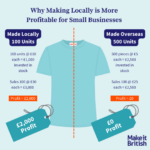Worried about manufacturers pricing in an increasingly competitive global market? Curious about the key methods to determine procurement pricing models and wanted to learn techniques to crack the best deals?
When closely observing products sourced from China, the purchasing price is the primary concern for buyers. Comparing prices across different manufacturers is a common practice during negotiations and helps inform the product sourcing and procurement process.
BrandNewMD will make inquiries and product negotiation on your behalf, across the vast network of suppliers.
Chinese product requirements rely on manufacturers’ pricing decisions. Smart play comes when you get a fair price without being harsh and rude.
Manufacturer’s Pricing Goals
While determining the pricing of the product the basic economic law of demand and supply is considered for the product run. The supply demand dynamics are only an external force but two other internal factors are crucial for the manufacturers i.e. the internal cost structure and pricing goals.
Manufacturer’s pricing goals can be summarized into the following 5 points
- To get sufficient expected returns – This is further divided into long-term and short-term returns.
- For a longer period –Introduce the largest total profit with control over revenue and total cost
- If there are insufficient potentials for expected or optimum profits, the pricing aims and objectives are reasonable profits based around the current market trends.
- Allocate lower prices for market occupancy, greater market share and substantial increase of product prices
- A detail study into the competitor’s strategies and set more competitive pricing to occupy the market or protect the existing one
BrandNewMD is a team of professionals, who give particular attention to the manufacturer pricing system and objectives. Once these goals are fully analyzed with the logic and reasoning behind it only then one can understand supplier’s pricing logic. Numerous sourcing services providers ignore these goals and fall into gross misunderstanding.

4 Methods for Manufacturer Pricing
1. “Cost + Profit = Price” Method (also known as “Cost Plus Method”)
It’s common in the market where there is monopoly of one product, particularly on the new product launch.
From the manufacturer’s perspective: The single product cost is $6.00. I want a profit of at least $4.00 (A cost/profit ratio of 60 percent). This means I price a single product at $10.00. (Prices are in U.S. dollars).
Moving towards the seller’s market, manufacturers have a greater influence in the pricing. This means the “cost + profit” method is quite common. It is crucial to note this method does not take an external market into consideration. An average cost is calculated, a profit percentage is added and the two are added together. This is the final product price.
According to a latest report by Statista, global manufacturing costs have risen by 7% on average over the previous years due to rising raw material prices and labor costs.
There are no such changes in the Average costs of products significantly as a general rule, and the profit of the industries are stable. The cost plus profit model remains prosperous as long as the other factors are stable. When there is a rise in raw materials or wages, many manufacturers increase prices across the board.
This pricing has no risk accumulation. All it needs is the product alternatives into the market niche. When the original manufacturers remain firm on their pricing and not accustomed to market transformation, they will soon lose their share of opportunity for better business development. This system has very little room for bargaining , instead agents work on the element of sale- such as reduced MOQ (minimum order quantity), payment terms, fast track delivery.
2. The “Price-Cost=Profit” Method
In competitive markets, this is a frequently adopted method.
The manufacturer’s perspective: The market product is fierce, and I cannot make changes in the supply or demand relationship. The product price is fixed. Therefore, if I am going to make an average profit, I have to look at internal operations and reduce costs there.
This pricing method tracks the market competition and profit margins of businesses. The method then seeks a balance between each one of them.
Manufacturers choosing this type of models rarely entertain any bargaining.The price of the supplier is the price of the market. It is necessary for the sourcing company to maintain the quality of the product and prevent manufacturers from interfering with the rights of buyers.

3. The “Price-Profit=Cost” Method
This method is applied in sunset industries. Industries that are being phased out because the development trends are beyond their capabilities.
The manufacturer’s perspective: The competition is overwhelmingly fierce.
Changing the supply demand relation is beyond my control. We have worked day in and day out within R&D but cannot decrease production cost any further now. This means that in the upcoming years there are no possibilities of cost reduction. The only choice left is profit reduction.
Research from the Harvard Business Review revealed that 58% of procurement professionals believe understanding supplier pricing methods is essential for effective negotiation.
Excessive competition within an industry means there is little room for improvement.
The products within the industry are copied massively, manufacturers cannot control pricing,they are in a situation where they can go onto the market and space for reducing costs is depleted. This means their only chance of survival is product upgradation or transforming existing facilities for new development opportunities and exposure in the market.
Manufacturers with this pricing method mean the profit margins are incredibly low. Your business will need to look for diversified niche markets or make unique products to stay away from business difficulties and issues.
4. Jump pricing method
In this method price comparison is not dealt with in the traditional way or with the new products in the market.
The manufacturer’s perspective: I am not 100 percent sure for the best price. Let’s observe what happens when I quote you a price on products and find one that the buyer is comfortable paying.
This method is usually adopted when the production cost is the same.
Each manufacturer will quote prices, this pricing method has a small relationship to the production cost. The cost depends on the supply and demand law. Short supplies and small orders with urgent delivery also means higher prices.
Manufacturers who opt for this pricing method are aware of the fact that there is no true partnership between buyer and supplier. It is a short-term relationship, and manufacturers will look into short term benefits. The product prices are reasonable where there are long term objectives of grothe and partnership- not just one-time purchase of product.
It is important to realize the buyer needs to be firm and fair. Many times a buyer will promise a significant future order as part of the price negotiation. Manufacturers see through this charade easily. The outcomes are never in the favor of the buyer.
Final thoughts
BrandNewMD bargains the best possible deal with manufacturers based on these four criteria. However there are times when price could not leave further room for negotiation and then comes the point where we shift our negotiation strategies into other possible areas of your order- which includes Low MOQ, fast track delivery or improved quality.








